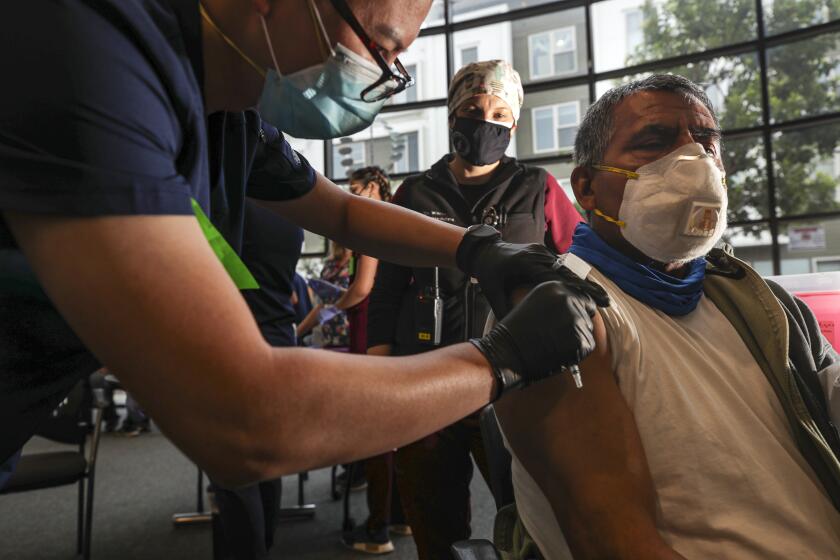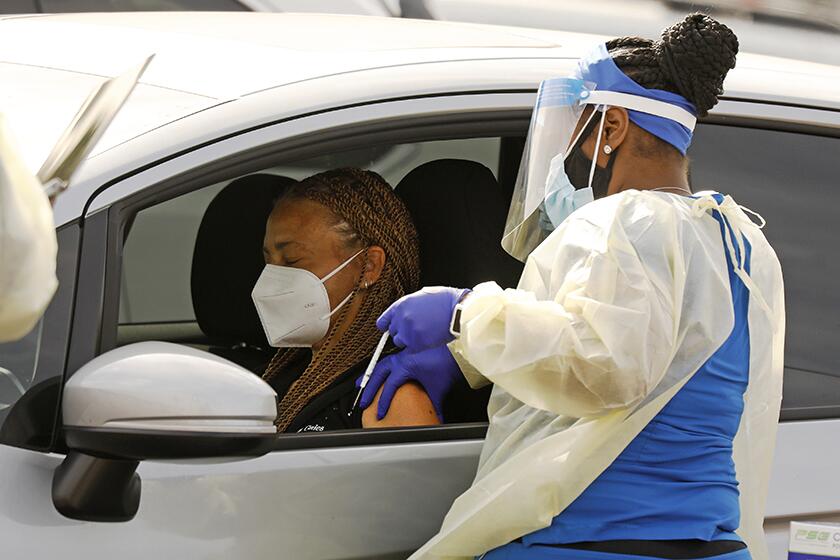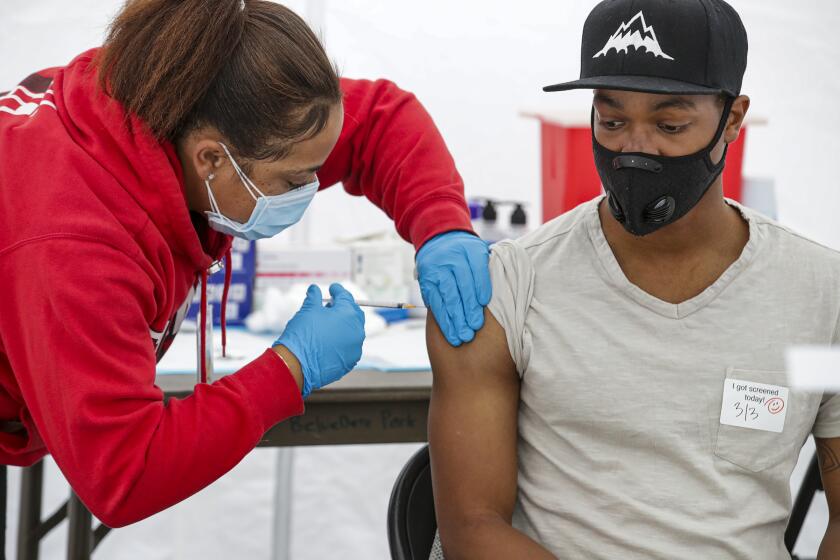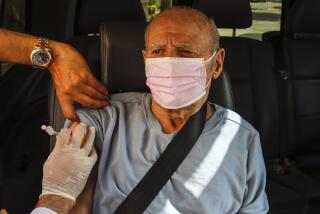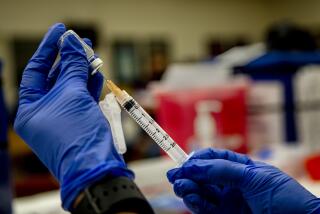Can California’s vaccine supply and technology keep up as millions become eligible?
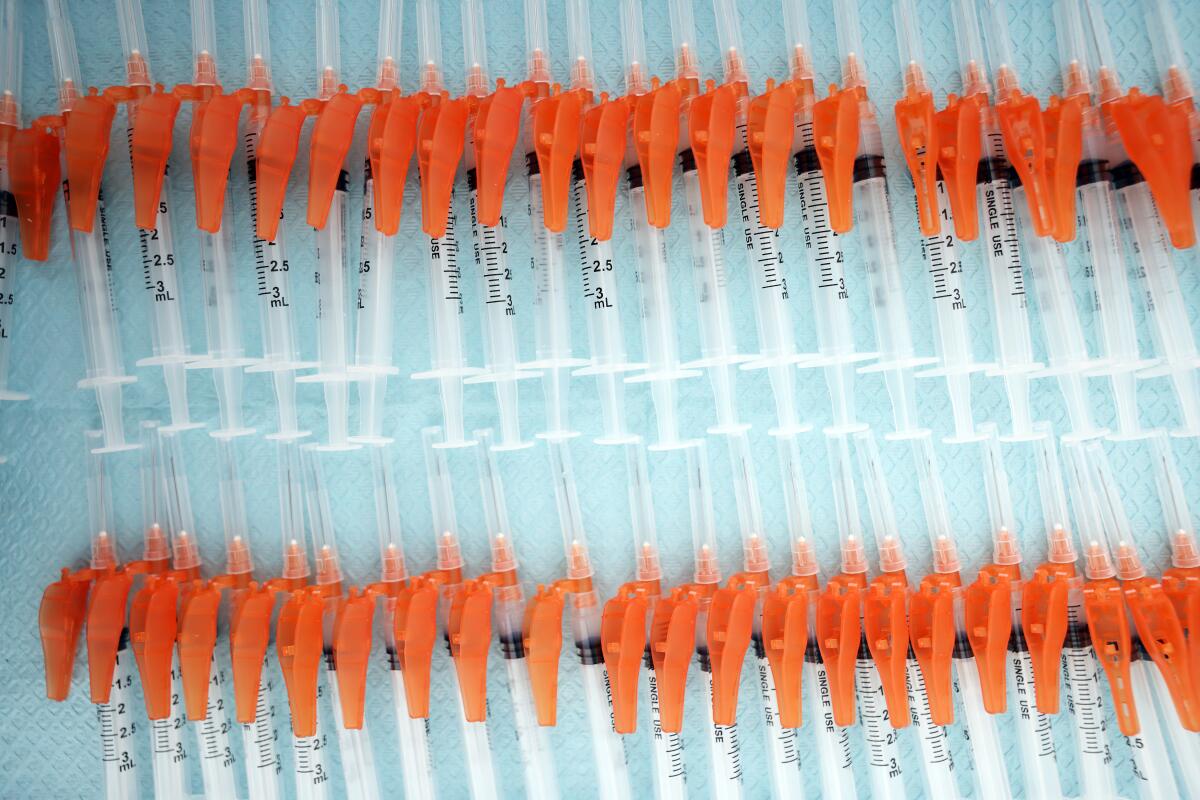
- Share via
The expansion of COVID-19 vaccine eligibility to everyone age 50 and older will be the biggest test yet for California’s vaccine effort, which has stabilized recently but still faces questions about whether supply and appointments can keep pace with demand.
Millions more Californians qualify for a shot starting Thursday, and in two weeks, all residents 16 and older will be eligible.
For most people, actually getting a dose will involve wading into California’s vast array of appointment websites run by local health departments, private health providers and clinics, several major pharmacy chains and the state, through a portal called My Turn.
Public health officials are urging newly eligible people to be patient while searching for an appointment because the supply of vaccine doses coming from the federal government is still constrained in some places. Officials in several major counties have said they could vaccinate far more people if they received more supplies.
Officials in Los Angeles County estimate it has the capacity to administer 700,000 doses per week, but supplies have yet to reach that level.
“It’s impossible for us not to be alerting people to the fact that they are going to perhaps need to wait for a couple of weeks before they’re going to be able to get those appointments,” L.A. County public health director Barbara Ferrer said Wednesday.
Reaching that milestone “would dramatically change the trajectory of the pandemic,” Public Health Director Barbara Ferrer said
An estimated 1.4 million L.A. County residents will become eligible April 1, and nearly 4 million people ages 16 and older will become eligible April 15, Ferrer said.
Across the state, more than 30% of residents have received at least one dose of the vaccine, totaling more than 18 million doses.
State and local officials have continued to prioritize equity in the vaccine distribution — a key to the state’s reopening plan — but ongoing constraints in supply could further hinder those efforts to reach the hardest-hit communities.
In Los Angeles, Ferrer said capacity is not going to be a limiting factor.
Now that eligibility is expanding to all California adults, we’ve put together a list of the different ways you can try to make an appointment to get a COVID vaccine in Los Angeles County.
“As soon as there’s an increase in doses, we’re going to be able to translate that immediately to more appointments for people who are eligible to get vaccinated,” she said, noting that the county this week received fewer than 400,000 doses, which limited the number of appointments it could provide.
Officials have been relying on an influx of doses in April to keep pace with the growing eligibility, with Ferrer on Wednesday projecting that if L.A. could continue to acquire 576,000 or more doses per week by the end of April, more than 80% of the county could be vaccinated by the end of June. Yet Johnson & Johnson said late Wednesday that a batch of vaccine failed quality standards and can’t be used.
Ferrer said L.A. County had been anticipating that about 20% of its doses over the next three months would be Johnson & Johnson. The drugmaker didn’t say how many doses were lost, and it wasn’t clear how the problem would affect future deliveries.
Officials in Santa Clara have also warned that while demand increases, supply has remained limited.
The system makes it difficult for counties to reserve vaccine appointments and allows wealthier people to take advantage, L.A. County officials say.
“We’ve had scarcity of vaccine and that continues,” Santa Clara County COVID-19 testing and vaccine officer Dr. Marty Fenstershieb said earlier this week.
The tight supplies are also translating to difficulty securing appointments, many Californians said.
My Turn, the state’s online appointment hub, was prone to glitches at the start of the vaccine rollout. To date, 2 million of the state’s 18 million administered doses have been booked through the site.
The issues have mostly improved as vaccine supply and appointment availability have increased. But in addition to the state site, a patchwork of websites operated by local health departments, private health providers and several major pharmacies have sprung up to meet growing demand. Some counties — and residents — have abandoned the platform altogether.
Billed as a one-stop shop for an appointment, My Turn does not include slots from many of the state’s biggest providers, including health chains such as Kaiser Permanente, retail pharmacies such as CVS and Walgreens, third-party providers such as Carbon Health in Los Angeles and Othena in Orange County, and smaller clinics that operate on a platform called CalVax.
“It is a genuine challenge to find an appointment,” said Echo Park resident David A.L. Venable, 29, whose severe asthma puts him at high risk for COVID-19. “That My Turn is a pain and challenge to navigate to this extent does not bode well for the expansion.”
Carlos, a 26-year-old legal worker who asked that his last name not be used, said he will be skipping My Turn and going straight to CVS when he becomes eligible. “I find it way easier to navigate,” he said, noting that he already used the pharmacy’s site to make an appointment for his mother.
To address problems with My Turn, the state allowed residents to sign up for an appointment at least one day before the expansion. That change was in order to prevent sign-up snags that occurred on March 15, when nearly 5 million more residents became eligible in the state and rushed to find an appointment.
Despite the modification, appointments have still been difficult to obtain. Several residents on a popular vaccine appointment group on Facebook said the site locked them out of first-dose appointments because there were no available openings for second-dose appointments further down the line. Others said not every vaccine site comes up in a given ZIP Code, and recommended typing in a list of 10 different cities so as not to miss a location.
After some difficulty, Orange County resident David Chang, 52, said he was able to use My Turn to secure an appointment at the East Valley Community Health Clinic, but noted that the site wasn’t user-friendly.
“You have to answer all the eligibility questions each time before getting to the scheduling page, only to find out that no openings are available,” he said.
As with earlier stages of the vaccine rollout, Californians have also been confused about varying eligibility across the state, and about whether and when it’s acceptable to cross county lines for a dose.
A handful of counties have already expanded eligibility prior to the state guidance. In Contra Costa, for example, officials announced Tuesday that all residents 16 and older were eligible for the vaccine after roughly 44% of the county has received at least one dose. The newly eligible group was directed to a county-run website to schedule appointments, since the county clinics were not currently set up on My Turn.
So far, the California Department of Public Health has reported that about 24% of the state’s vaccine supply — or roughly 4.3 million doses — has gone to those ages 50 to 64, either because they were already included in various eligible categories or they live in counties that have already expanded eligibility beyond the state guidance.
On Wednesday, Ferrer said that despite known issues, the county was “excited to expand eligibility” to more people.
“We do ask both those currently eligible and those that will be newly eligible to be patient as supply increases,” she said.
Times staff writers Luke Money and Maloy Moore contributed to this report.
More to Read
Sign up for Essential California
The most important California stories and recommendations in your inbox every morning.
You may occasionally receive promotional content from the Los Angeles Times.
